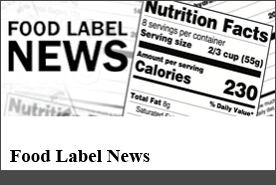
August 2017 - Volume 17, Number 8
Greetings!
In between your summer reading and vacation, take a look at how to handle labeling for ingredients that are at small or insignificant levels in your formula. Ingredients at 2% or less and incidental additives are treated differently according to FDA regulations. In this issue, you’ll also learn what to do when color is also an allergen in our Reader Q&A. Lastly, read up on all the new regulations from 2016 to ensure your nutrition labeling plan is on track.
In this issue:
- Ingredients at 2% or Less and Incidental Additives
- What's News in the Food Label Community
- Reader Q+A: Labeling When Color is an Allergen
- Reader Favorites: 2016 Regulatory Roundup
Best,
![]()
Karen C. Duester, President, Food Consulting Company

Ingredients at 2% or Less and Incidental Additives
Food labelers are aware that FDA regulations require that every ingredient be listed by common name in order of predominance in the final product. There are, however, circumstances that allow flexibility in this general requirement. The scenarios we have covered in recent months include use of: 1) collective names, and 2) composite ingredient lists. Two additional scenarios for ingredient lists are: 1) small amounts of ingredients, and 2) incidental additives at insignificant levels.
Small amounts – The first scenario that allows flexibility in creating the ingredient list is when there are small amounts of ingredients in the final formulation. There is a choice to either: 1) list in order of predominance like any other ingredient, or 2) at the end of the ingredient statement with a clause such as "2% or less of the following" and then list the minor ingredients in any order. Note: if the minor ingredients are even less than 2%, it is acceptable to use 1.5%, 1% or 0.5% in the clause.
There are several reasons why it could be advantageous to us the "2% or less" clause.
- Proprietary formula – Often it is strategic to keep the exact formulation concealed so that competitors cannot easily duplicate it. Using the "2% or less" clause enables the specific formulation to stay proprietary.
- Functional ingredients at varying levels – Some ingredients are used for a functional purpose, such as adjusting pH or acting as a preservative, and their levels can vary depending on the specific batch. For example, if citric acid is used to adjust pH and there are other ingredients in the 2% or less category, the "2% or less" clause enables a single ingredient statement to be used without concern for exact ingredient levels and batch-to-batch variances.
- Marketing support – For some foods, ingredients may have a somewhat negative consumer perception and detract from a brand’s positioning. Using the "2% or less" clause reassures consumers that there is a very minimal amount of such ingredients in the product.
Incidental additives – The second scenario that allows flexibility in creating the ingredient list is when there are trace amounts of ingredients in the final formulation. According to 21 CFR 101.100, if ingredients are present in a food at insignificant levels and provide no technical or functional effect, these ingredients do not have to be listed in the ingredient statement. FDA defines incidental additives as:
- Ingredients that are incorporated in the food as an
ingredient of another food; an example is alcohol in a natural flavor
- Processing aids added during processing but removed,
converted to a normal constituent of the food present at normal levels, or
are present at insignificant levels; a common example is a chlorine wash
used on fruits and vegetables
- Substances migrating from equipment or packaging, such as canola oil used to lubricate a production line
Note incidental additives should always be listed in the ingredient statement when they are:
- Allergens, such as soy lecithin used as a lubricant
on equipment
- Sulphiting agents at detectable levels (greater than
10ppm), such as sulfur dioxide
- Functional in the finished product, such as a preservative in another ingredient that also functions as a preservative in the finished food

What's News in the Food Label Community
- Carbohydrates in citric acid (13+ comments)
- Wholesome claim (8+ comments)
- Authentic claim (7+ comments)
- Dried vs. dehydrated (6+ comments)
- FDA Draft Guidance vitamins and minerals (6+ comments)

Answers to Your Important Questions
Q. My
product uses carmine color that is derived from a cod fish protein. How do I
declare this on the ingredient statement since fish protein is an allergen?
— N.S., Manufacturer, Thailand
A. Carmine is one of the color additives that must always be listed by common or usual name within the ingredient statement. The fact that your carmine is derived from fish, one of the big 8 allergens, also requires that you alert consumers about a potential allergic reaction by specifying the exact species of fish. MORE

In Case You Missed It...

What Matters Most in Food Labeling
Food Label News, now in its 17th year, is a monthly e-newsletter reaching over 10,000 subscribers around the world. We welcome your colleagues to subscribe for news and insights about food labels.
